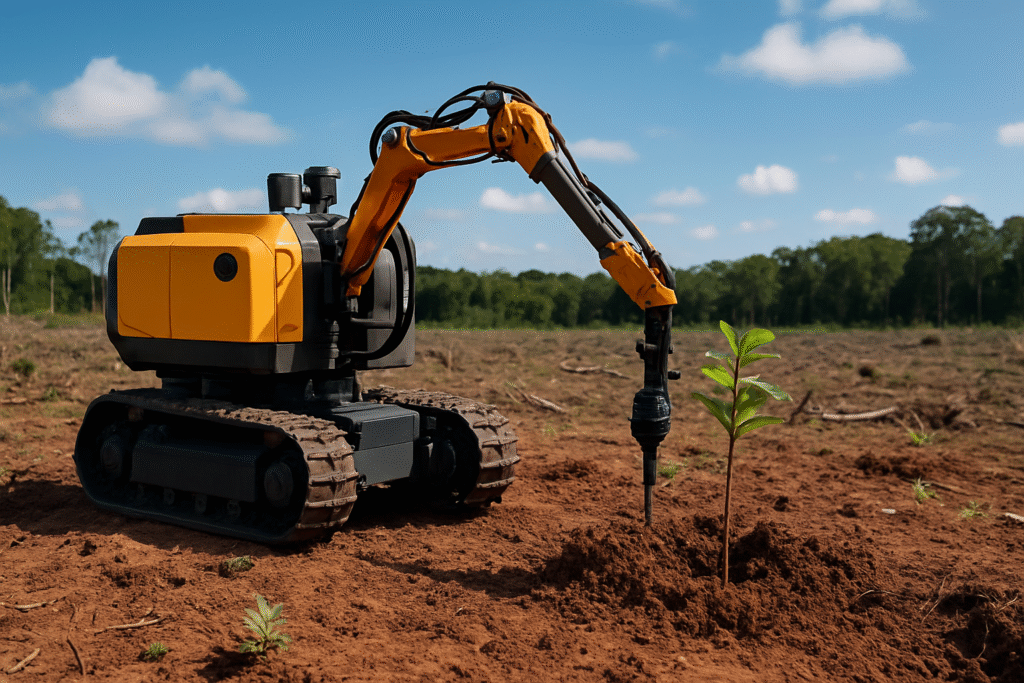In Brazil’s countryside, a new kind of helper is quietly changing the fight against deforestation Brazil tree-planting robots. These smart machines can plant more than 100 trees per hour, study the soil and sunlight, and choose the perfect native trees for each spot. It’s like having a farmer, scientist, and engineer all in one.
How the Robots Work
These robots aren’t just digging holes. They are equipped with AI, cameras, GPS, and soil sensors. First, they scan the land to check. Soil moisture and pH, Amount of sunlight, Land shape and slope, Existing plants nearby.
Once they collect this data, the AI picks the right native species for that exact location. Then the robot plants the seedling with precision and records its GPS location for future monitoring. This means the process is fast, accurate, and designed to help trees survive not just get planted.
Why Speed and Precision Matter
Brazil has millions of hectares of land that need reforestation. Planting by hand is slow and physically exhausting. If one robot can plant thousands of trees a day, large areas can be restored much faster.
But speed alone isn’t enough. If the wrong species are planted in the wrong place, the trees might die. That’s why Brazil tree-planting robots focus on matching the right tree to the right spot just like nature does.
The “Forest.bot” Project
One Brazilian project called Forest.bot has been working on large farms and degraded lands. The robot can plant thousands of seedlings per day with GPS precision. In one pilot program, it restored 50 hectares of land in just three weeks a task that would have taken months for a human team.
Local nurseries supply the seedlings, ensuring that all species are native to the region. This approach creates jobs for nursery workers and ensures better survival rates. Dr. Lúcia Amaral, an environmental scientist in São Paulo, says. Robots can do the heavy lifting, but real success comes from ecological planning. If we feed them the right data, they can transform reforestation from a slow dream into a fast reality.
She also warns that planting is just the first step young trees need care, protection from pests, and water during dry seasons. Maria, a technician who works with one of these robots, shared her story. Before, we spent all day planting in the heat, and we could only do about 300 trees. Now, the robot plants most of them, and we focus on watering, checking for pests, and making sure the seedlings grow strong. It saves our energy and improves the results.
Lower planting costs, more green jobs in nurseries and robot maintenance. Restores biodiversity faster and more accurately. Local workers still play a vital role in caring for new trees. The challenge? Robots need good seedlings, transport, and long term monitoring. Planting quickly means nothing if the trees don’t survive.
The Future of Brazil’s Reforestation
With government support, private companies, and environmental groups working together, Brazil tree-planting robots could help restore massive areas of forest. Imagine drones mapping the land from above, robots planting below, and people caring for the young trees until they grow into thriving forests.
If done right, these machines could be the fastest way to heal the Amazon and fight climate change turning bare land into green life, one smart seedling at a time. Technology can’t replace nature’s wisdom, but it can help us repair the damage faster than ever before. Brazil tree-planting robots are a powerful reminder that when humans and machines work together, we can bring the forest and our future back to life.

